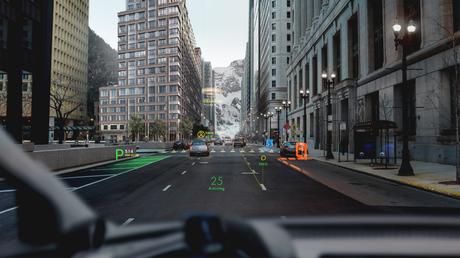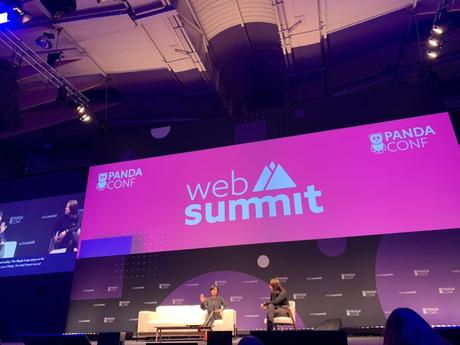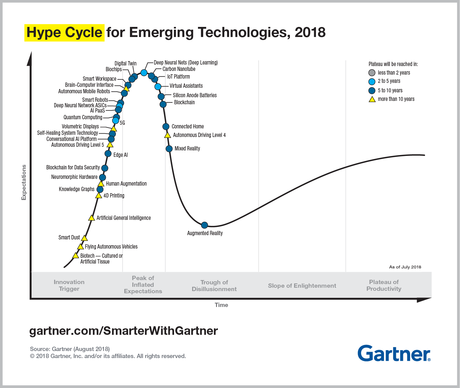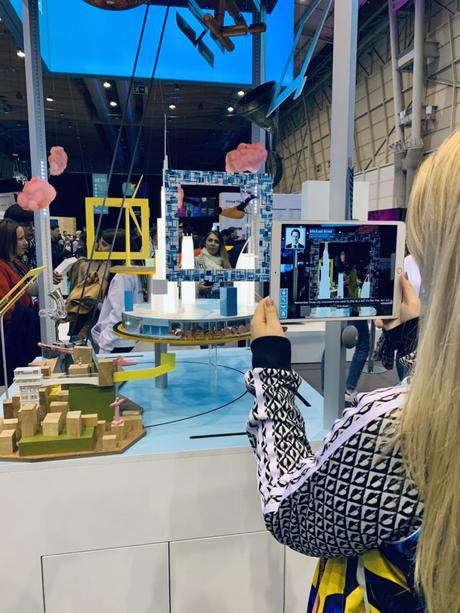It has been two weeks since Web Summit took place in Lisbon, Portugal and we can still feel the energetic vibes. 3 days full of inspirational speakers, current tech trends, coffee astronauts, robots (have you seen the new social robot Furhat revealed at the summit?), diversity in tech and much more. But out of all, I was personally most excited about the interest that big companies are putting more and more into AR, VR and MR technologies.
Augmented reality still seems to be trivial for some, but when industry leaders like Google, Porsche and AliBaba are heavily investing in this technology, we know it will soon become a commodity in our daily lives. There were many tech talks, startups and partner exhibitors that were putting focus on it and here are some highlights:
Eyes on the road: How AR will change the car industry?
 WayRay’s Vitaly Ponomarev and Porsche’s Christian Knörle joined forces to talk about the opportunities and challenges of AR in the car industry.
WayRay’s Vitaly Ponomarev and Porsche’s Christian Knörle joined forces to talk about the opportunities and challenges of AR in the car industry.
WayRay is a Swiss startup that develops holographic AR technologies for connected cars and managed to raise more than 100$M in investments since they launched in 2012. Today the main application is to assist drivers with the navigation, but with the self driving cars of tomorrow, it could extend to much more.
Ponomarev got the idea of the business after an accident he got into because he was distracted by the GPS navigator. This is a great example of how AR can be used for improving our daily lives, not just for entertainment purposes. He also has a very interesting point of view regarding self-driving cars, in a sense that AR can be a powerful tool to build the trust between passengers and car. By projecting what the car is seeing and thinking, the passenger can understand that the car makes the right decisions. The biggest challenge of WayRay now is to industrialise the technology.
Their business plan to develop the hardware and software, together with a True AR SDK for 3rd party developers which brings endless possibilities. WayRay also had a True AR Challenge hackathon this year and it’s interesting to look at the projects to get some inspiration and more understanding of this technology.
Knörle compares that adopting AR in our daily lives would be similar to the experience of getting prescription glasses when you have vision problems. Looking forward to that!
Magic Leap: from concept to augmented reality
 CMO of Magic Leap Leap Brenda Freeman gave us more insights on one of the most anticipated piece of technology in the AR world. With 5 cameras in the headset, 3 world cameras that mesh the room and 2 cameras for eye tracking, Magic Leap goes a bit further than augmented reality into mixed reality.
CMO of Magic Leap Leap Brenda Freeman gave us more insights on one of the most anticipated piece of technology in the AR world. With 5 cameras in the headset, 3 world cameras that mesh the room and 2 cameras for eye tracking, Magic Leap goes a bit further than augmented reality into mixed reality.
Virtual reality (VR) is a completely immersive virtual experience, augmented reality (AR) overlays virtual objects on the real-work environment, and then there’s mixed reality (MR) which is the merging of real and virtual worlds to produce new environments and visualisations where physical and digital objects co-exist and interact in real time.
Those technologies will have great applications on communication, entertainment, gaming, e-commerce and many more and that is why early adopters are already developing and investing in them. An example of early experimentation is the collaboration between Magic Leap, H&M and Warpin Media for the new Moschino collection (video).
Right now their focus is to get developers and creators to build and test everyday use cases on the platform and then later they will be able to sell the headset to consumers. They recently had a developers conference to showcase what is possible with Magic Leap and inspire new ideas.
When asked about the future of those new technologies, 5-10 years down the road, Freeman said:
“We believe this will be the next disruptive computing platform in the generation to come”
Another great take-away from her talk was:
“We talk so much about future forward. Future is now! If you aren’t thinking of how to disrupt your respective industry then you’re behind.”
Our augmented future: What’s next for AR?
Ambarish Mitra from Blippar, a leading augmented reality and computer vision company, came to the Creatiff stage to talk about the evolution and future of augmented reality.
The computing interface started with the touch experience though keyboards and touchscreens, then it evolved into the area of natural language with AI assistants like Siri and Alexa, and now into the final frontier which is vision with augmented reality. Mitra also explained that even though AR and AI were positioned as separate industries, they are very deeply linked as AR cannot properly scale until computers can understand reality with the help of artificial intelligence.
When looking at the business opportunities of AR, the CEO of Blippar says that AR can be a very profitable industry, way higher than VR. The Gartner Hype Cycle for Emerging Technologies 2018, shows AR will reach mainstream adoption in 5-10 years:

Mitra showcased some examples of how AR is already impacting different industries. For example, retailers are using AR for magic mirrors to virtually try on clothing or connecting offline content like a coat in a store with online content like reviews and other recommended items (video). Blippar has a lot more great inspirational videos of AR business ideas on their Youtube channel.
On the second part of his presentation, Mitra gave a few demos of AR applications: a retail environment where you can engage with the products (using the Magic leap headset), a life on Mars experiment, a fitness scanning app and audience coloured butterflies that “come to life”.
Besides those amazing talks, we’ve seen artists using AR and VR as a new way of storytelling, startups with disruptive ideas and partner’s stepping up their exhibition’s game with AR capabilities. A great example was Siemens who used AR to tell employees stories with a new twist.
 —
—
Fun fact: There were 69.304 attendees which on average walk 13.5 km at Web Summit = 935.604 km. Together we reached the moon. Twice!
Resources
- You can checkout many of the talks on the [Web Summit’s Youtube Channel]
Indlægget Augmented reality is here to disrupt the industry: Insights from Web Summit 2018 blev først udgivet på Nodes UK.

